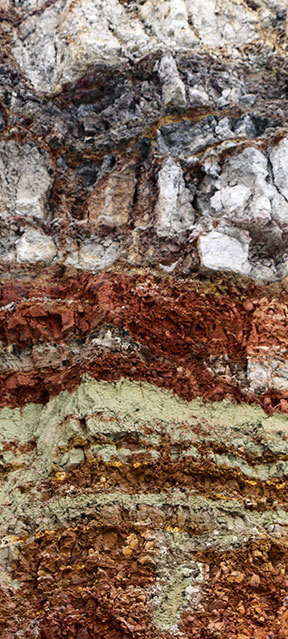Clays
Common beliefs

Common beliefs on clays
Grain size merely stands for the dimension of clay grains after drying / crushing. It is commonly obtained by sifting.
The size of the grains (2 to 3 centimeters in diameter for crushed clay, going at less than 45 µm for an «ultra ventilated») don’t change the clays proprieties whatsoever. However, it will be easier to obtain a creamy paste with powdered clay than with big grains.
On an industrial scale, it is not possible to fully sun drying clays. A pre-drying is possible and economically interesting, as it significantly reduces the clay moisture content, although artificial drying is compulsory before crushing and sifting. Every company specialised in clays employ an industrial/artificial method of drying.
The colour of clay is mainly due to the presence of pigments and to the iron status: Ferrous or ferric. Ferrous tend towards green and ferric towards red.
The iron status does not interfere in the clay composition. Combined with oxygen,it will simply be in FeO (ferrous) or Fe2O3 (ferric).
It is important to understand that the colour of the clay does not determine its use. Only the clay family gives us indications on how to use it.
As an example, the montmorillonite and the Illite, even if they are both green, have very different properties.
Inversely, two clays of different colours (for example green and red), will have the same properties if they belong to the same family.
If you put clay in contact with metal (especially iron), it rusts.
In fact, in the presence of metals, clay can fix the metal cations, due to its adsorbent power.
Clay could even lose some of its ionic capacity if it stays in contact with metal during several days/weeks.
Metal will quickly rust and clay will be contaminated very quickly.
This point regarding metal with clay is due to the fact that before iron, silver or copper utensils were used most of the time. Therefore, oxidation was quickly taking place and it was better to use wood or ceramic instead.
Today, with stainless steel, this is no longer a problem.
Actually, it is better to use a clean metal spoon (preferably in stainless steel) rather than a wood spoon, which is inevitably microbiologically “dirty”.
Clays don’t have an expiry date.
This information is for reference only since the metamorphic mother rock needs millions of years to turn into clay mineral, the characteristics and properties of clay do not change at our time scale…
The only quick evolution can happen on the bacteriological level, for this reason clay must be kept in a dry environment and at room temperature.
